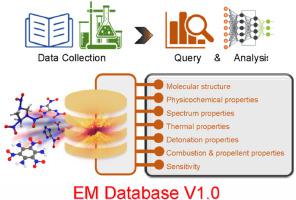EM Database v1.0: A benchmark informatics platform for data-driven discovery of energetic materials
IF 3.9
Q2 CHEMISTRY, MULTIDISCIPLINARY
引用次数: 0
Abstract
Large-scale data demonstrates great significance for the discovery of novel energetic materials (EMs). However, the open-source databases of EMs are not readily available. In pursuit of high-performance EMs before synthetic attempts in the laboratory, the theoretically predicted properties and experimental results that can be easily accessed are desired. Herein, a benchmark informatics platform of EMs, namely EM Database, has been developed for the purpose of data storage and sharing. EM Database v1.0 currently contains the properties of approximately 100000 unique compounds obtained through quantum chemistry (QC) calculations and the experimental results of about 10000 unique compounds extracted from literature. The QC data in the database were extracted via ground-state density functional calculations using the B3LYP/6-31G(d,p) method. These data include geometrical conformation, electronic structures, and predicted properties (i.e., crystal density, enthalpy of sublimation, molar heat of formation, detonation pressure, detonation velocity, detonation heat, and detonation volume) obtained using models of quantitative structure-property relationships. The experimental data were manually collected from literature and were then doubly curated by our project team members. These data include the physicochemical, thermal, combustion, detonation, spectra, and sensitivity properties. In this paper, we also discuss the techniques for constructing the EM Database and present the fundamental features of the database. The EM Database is expected to serve as an effective benchmark informatics platform for forthcoming research on EMs.


EM数据库v1.0:用于数据驱动的高能材料发现的基准信息学平台
大规模数据对发现新型能材料具有重要意义。但是,EMs的开源数据库并不容易获得。在实验室尝试合成之前,追求高性能的电磁,需要理论预测的性质和易于获得的实验结果。为此,我们开发了一个EMs基准信息学平台,即EMs数据库,以实现数据的存储和共享。EM Database v1.0目前包含了通过量子化学(QC)计算得到的大约100000种独特化合物的性质,以及从文献中提取的大约10000种独特化合物的实验结果。数据库中的QC数据采用B3LYP/6-31G(d,p)方法通过基态密度泛函计算提取。这些数据包括几何构象、电子结构和预测性质(即晶体密度、升华焓、摩尔生成热、爆轰压力、爆轰速度、爆轰热和爆轰体积),这些数据是通过定量结构-性质关系模型获得的。实验数据是手工从文献中收集的,然后由我们的项目团队成员进行双重整理。这些数据包括物理化学、热、燃烧、爆轰、光谱和灵敏度特性。本文还讨论了构建电磁数据库的技术,并介绍了该数据库的基本特征。新兴市场数据库有望成为即将开展的新兴市场研究的有效基准信息学平台。
本文章由计算机程序翻译,如有差异,请以英文原文为准。
求助全文
约1分钟内获得全文
求助全文
来源期刊

Energetic Materials Frontiers
Materials Science-Materials Science (miscellaneous)
CiteScore
6.90
自引率
0.00%
发文量
42
审稿时长
12 weeks
 求助内容:
求助内容: 应助结果提醒方式:
应助结果提醒方式:


